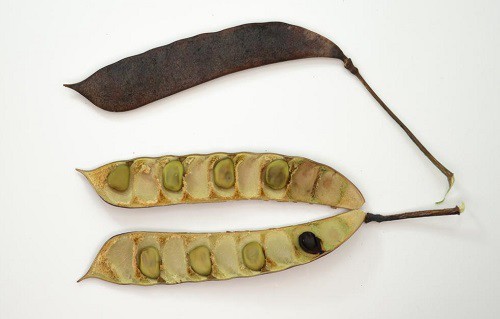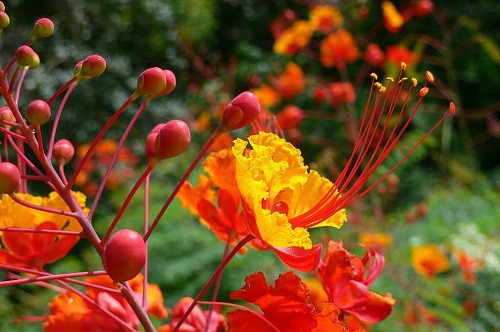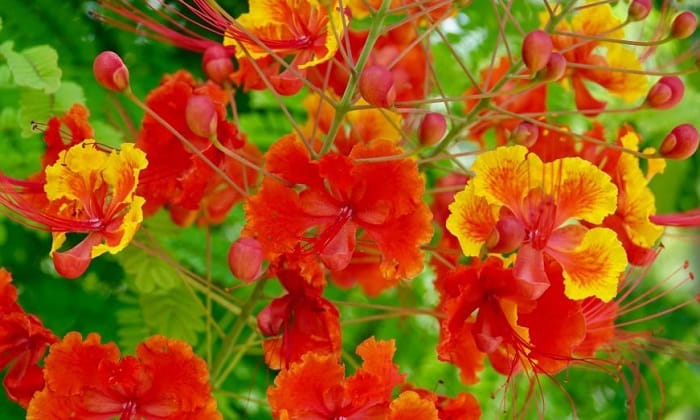The Pride-of-Barbados is an evergreen thorny shrub of medium to large size. It typically grows and blooms in tropical environments. Its vibrant yellow and red flowers can turn the head of any passerby.
Botanists acknowledge Pride-of-Barbados’ beauty through its scientific name, “Caesalpinia pulcherrima,” which translates to “very pretty.” It is usually planted around March 19- June 20 in Spring and June 21-July 15 in early Summer.
Did this plant catch your attention? Read on to know when to plant Pride of Barbados!
Table of Contents
Gardener’s Guide to Pride of Barbados Cultivation
1. Best time to plant pride of Barbados
The Pride of Barbados is thought to originate from the West Indies and tropical parts of America. It’s extensively grown and has successfully adapted to tropical climates.
Planting the Pride of Barbados in the spring or early summer, when the weather is warm but not overly hot, is advisable. The plant exhibits quick growth from seed, typically between 2 weeks to several months. Nonetheless, producing a truly spectacular bloom requires around 2 to 2 1/2 years.
The Pride of Barbados plant can grow to 10 feet as a shrub, while it soars to 20 feet in tree form. The flowering typically begins only when the temperatures rise significantly. Thus, its peak flowering period occurs during the harshest part of the summer, usually from June 21 to July 15.
2. USDA Hardiness Zone

The Pride of Barbados can thrive in USDA Hardiness Zones 8 to 11. In these areas, frost or freezing temperatures can cause the Pride of Barbados to die. On the other hand, it reliably reemerges in zone 8B, typically around mid-spring.
In climates free from frost, it manifests as an evergreen shrub or a small tree. However, in zone 9, it sheds its leaves to become a deciduous shrub; in zone 8, it acts as a perennial that regrows each year.
Although it’s a tropical plant, it can withstand lower temperatures and is drought-tolerant. That said, its growth may be less lush and appealing under such conditions.
Planting Instructions
There are two primary methods for planting the Pride-of-Barbados: using seeds or cuttings. Below are instructions for each planting method:
1. From Seeds
To propagate the Pride-of-Barbados from seeds, here is a step-by-step guide:
- Gently scratch the seed’s hard coating by rubbing it on a cement surface or sandpaper. This process allows water absorption for the seed.
- Soak the scarred seeds in warm water for 24 hours to promote germination.
- As the seeds appear swollen after soaking, you can plant them.
- Plant the seeds about 1/2 to 1 inch deep into the potting mix and sprinkle soil onton them.
- To create a conducive environment for germination, cover the pot with plastic wrap to retain heat and moisture.
- Place the pots in a sunny location and ensure the soil is moist.
- Germination usually occurs after 1 to 2 weeks but might be longer in some cases.
- Once the seedlings are big enough, you can transplant them into larger containers or directly into the ground.
2. From Cuttings
For plant propagation through cuttings, follow these steps:
- Take cuttings from healthy, fully-grown Pride-of-Barbados plants while they are actively growing.
- Choose 4 to 6-inch-long semi-hardwood cuttings that are neither soft nor woody.
- Remove the leaves in the lower half of the plant to reduce water loss.
- Immerse the severed tip of the stem in rooting hormone powder to encourage the development of roots.
- Put the plant stem into a potting mixture that allows water to drain well.
- Place the cutting in a warm and bright location
- to provide indirect light.
- Regularly mist the cutting to maintain a high level of humidity around it.
- Roots should start developing on the cutting within a few weeks to a couple of months.
Once the roots are well-established, transplant the cutting into a larger container or directly into your desired planting location in the garden.
Expert Tips for Pride of Barbados Care
- Soil
The Pride of Barbados is well-suited for cultivation in both alkaline and acidic soils. It can adapt to various soil types, such as sandy, loamy, and clay, provided they have good drainage. Furthermore, this plant exhibits a notable tolerance to salty conditions.
- Water
Consistent watering encourages healthier growth and more abundant flowering. Watering needs may vary depending on specific environmental conditions, such as temperature, humidity, and soil drainage, so regularly monitor the plant’s moisture requirements. Additionally, excessive watering should be avoided to prevent root rot.
- Sunlight
To achieve stunning and fiery blooms, ample sunshine is important. While they can tolerate some shade, they grow best when fully exposed to sunlight.
FAQs
Can I grow the pride of Barbados in pots?
Certainly! You can plant the Pride of Barbados shrub in a pot from seeds or cuttings, and place it indoors or on your patio. Just make sure they receive enough sunlight.
Is Pride of Barbados compatible with central Texas?
Yes. Since Central Texas falls under USDA Hardiness Zone 8B, they are capable of growing the pride of Barbados in the state.
What are the health benefits of Pride of Barbados?
The leaves of the Pride of Barbados are utilized for various medicinal purposes, such as treating kidney stones, malaria fever, and bronchitis.
Conclusion
Whether you plant it from seeds or cuttings, you’ll be rewarded with Pride of Barbados’ beauty. With the help of this guide, you are now aware of when to plant pride of Barbados and caring for this evergreen shrub.
Adorn your landscape with the vibrant colors of Pride of Barbados. With this plant, you can lend an air of exotic beauty to your outdoor space. Take advantage of the chance to elevate your garden to new heights of tropical splendor!

Hi, I am William – Floridayards’ digital content creator. My job is to find answers to all your concerns with thorough research and our team’s expert advice. I will also bring you honest reviews on the best products and equipment for raising your beautiful garden. Please look forward to our work!















